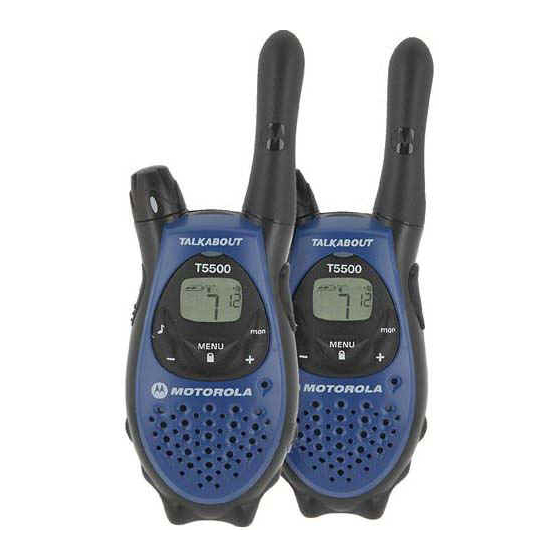- ページ 8
ラジオ Motorola TALKABOUT T5500のPDF 通信マニュアルをオンラインで閲覧またはダウンロードできます。Motorola TALKABOUT T5500 16 ページ。 Frs/gmrs recreational two-way radios
Motorola TALKABOUT T5500 にも: ユーザーマニュアル (36 ページ), ユーザーマニュアル (17 ページ), ユーザーマニュアル (5 ページ)

.A FRS/GMRS radio requires a FCC "family" license which costs $85; there is no
examination. (www.fcc.gov). The radios are larger, can put out up to 5 watts on 15
GMRS UHF* channels, and cost about ~$30-80. GMRS bubble pack radios that you
buy in most stores also include the FRS channels. You do not need to buy a radio that
includes GMRS power and channels for CERT use. However, if you can afford
BOTH the license and the more expensive FRS/GMRS radio you should consider
buying one because the extra power allows these radios to transmit over a somewhat
greater distance. That will be helpful particularly if you use the radios for outdoor
recreational activities (hiking, skiing, fishing, boating, or car to car
communications when caravanning). If you want such a radio you can use it in
CERT exercises and during a disaster but without a GMRS license you cannot
legally use the exclusive GMRS channels 15-22 (Motorola plan) or more than ½
watt power.
To obtain information and purchase your GMRS operator's license, you should
access the FCC (Federal Communications Commission) online at
by phone at 1-888-CALL-FCC or 1-877-480-3201. Or you may e-mail the FCC for
licensing help at:
Amateur Radio ("ham radio") operation requires a FCC license which is obtained
by taking an exam. It covers FCC rules, operating procedures and radio/electronics
theory, but no longer has any Morse code requirement. Hams can use many different
kinds of radio equipment and higher power which allows them to communicate
around the world by radio. Hams have always been heavily involved in emergency
communications. Arroyo Seco area hams were asked by the Arroyo Seco
Neighborhood Council's Public Safety Committee to help with CERT
communications. We badly need more amateur radio operators ('hams") for our
CERT communications, so go to
get your FCC license.
3) Operating Practices and Regulations: what you should know
• No intentional interference with another radio station is allowed. The channels
used by FRS and GMRS are all shared on a "party line" basis. That means
whoever is there first can use that frequency (another term for channel) until they
are done; then you can use it. It is important to listen before transmitting on the
channel you are about to use. If that channel has a "privacy code" set on your
radio you must push the Monitor (Moni) button before listening for others using
the same channel so that you don't interrupt ongoing communications. Also, don't
hog a channel just because you got there first.
• Emergency communications always have precedence so that if there is an non-
emergent conversation on a channel and you need to deal with a life or property
threatening situation, the channel should be given up to you. Most FRS and
For disaster communication in the ASNC area, tune to FRS Channel 2 (Alternate: Ch 12)
Ham Radio Operators should also tune to Battalion 2 simplex 145.585 MHz, PL 110.9
http://www.hello-radio.org/
www.FCC.gov
or
or ask any ham how to
8
